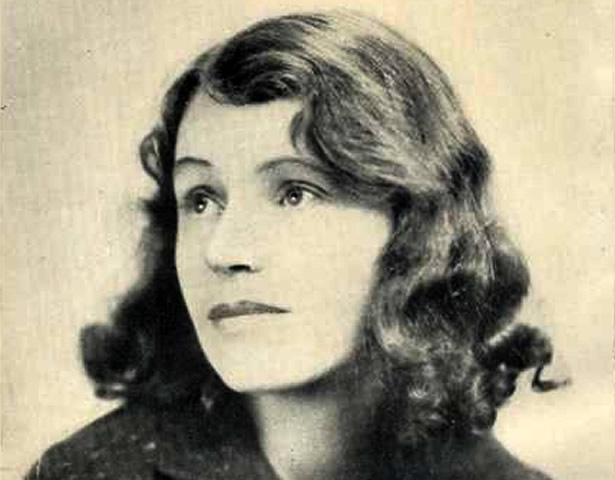
Robin Hyde packed a lot into her short and often tragic life. Best known today for her novels Passport to hell, Nor the years condemn and The godwits fly, she was also a fine poet, a crusading journalist and an outspoken advocate for the downtrodden.
Born in Cape Town, South Africa, Iris Wilkinson came to New Zealand with her English-Australian parents when she was a month old. Settling in Wellington, the Wilkinsons rented a series of dingy houses in Newtown, Melrose and Berhampore. The story of her early life is told in her autobiographical novel The godwits fly (1938), and in a series of poems published as Houses by the sea (1952).
Iris attended Wellington Girls’ College, where she had many poems and stories published in the school magazine. At 17 the ‘Schoolgirl Poetess’ joined the staff of the Dominion newspaper. The following year she spent some months in hospital after a knee operation. She came out on crutches, dependent on opiates for pain relief, to find that her lover had gone to Europe without her.
In 1925 she wrote a ‘Peeps at Parliament’ column under the pen-name ‘Novitia’. The politicians William Downie Stewart, Daniel Sullivan and John A. Lee became lasting friends. A brief love affair while receiving treatment for her knee in Rotorua left her pregnant. In April 1926 she sailed for Sydney, where she gave birth to a son, named Robin Hyde, who died soon after. She would later borrow his name as a pseudonym for her serious writing. Back home she spent some months in Queen Mary Hospital, Hanmer Springs.
In the late 1920s Hyde worked for New Zealand Truth, the Christchurch Sun and the Wanganui Chronicle, inserting controversial interviews or subversive comments into the society or shopping columns. She became pregnant to a married journalist who suggested she pay half the cost of an abortion: ‘Well, I thought, you can’t say we haven’t got sex equality’. Hyde instead took six months’ sick leave and gave birth to a son, Derek Challis, in October 1930. Rumours lost her the Whanganui job and she returned penniless to Wellington, smuggling her son onto the ferry in a dress-basket. He was placed in a nursing home and later fostered by an Auckland family.
Hyde now became lady editor of the New Zealand Observer. As the Depression worsened, she wrote articles on vagrant women and soup kitchens while reporting on fashion and balls in the society pages. She was present at the Queen Street riots in 1932. At this time she met Douglas Stark, the ex-borstal boy and war hero who became the model for ‘Starkie’, the protagonist of her novels Passport to hell and Nor the years condemn.
The pressures of life in sordid boarding houses and the temptations of morphine were too great. In mid-1933 Hyde tried to drown herself. After six weeks in a basement ward of Auckland Hospital, she entered the Grey Lodge at Auckland Mental Hospital as a voluntary patient. Helped by her doctors, she resumed writing. In her four years at Grey Lodge, she completed Journalese (1934), the novels Check to your king (1936), Passport to hell (1936) and Wednesday’s children (1937), and two collections of poetry, The conquerors (1935) and Persephone in winter (1937). She was also freelancing for the Observer and the New Zealand Railways Magazine, and working on drafts of The godwits fly and Nor the years condemn (1938).
After Hyde left Grey Lodge in 1937, she lived for a year on ‘bread and butter, tea and the tin opener’ in baches around Auckland. Becoming more assertively feminist and socialist, she wrote for Tomorrow and Woman To-day and also sought to publicise Māori grievances.
In 1938 Hyde sailed for England, but instead landed in war-torn China. Undeterred by Japanese bombing, she visited Shanghai and Canton (Guangzhou) and obtained a pass for the front lines. Her harrowing journey into the war zone was chronicled in the book Dragon rampant, some of her finest poems, and many articles. When Hsuchow (Xuzhou) was bombed and captured, she limped for 80 km along the railway line towards Tsingtao (Qingdao). Assaulted by Japanese soldiers, she sustained a painful eye injury which was treated by a Japanese doctor.
After further treatment in Hong Kong, Hyde finally reached London in September 1938. She finished Dragon rampant and was active in left-wing and pacifist groups. But as war approached in 1939 she was living in the attic of a Kensington boarding house, broke, ill and depressed. John A. Lee arranged to bring her home, and on 23 August New Zealand’s High Commissioner, Bill Jordan, visited her to confirm travel plans. He found her dead by suicide, having taken Benzedrine earlier that day. She was 33 years old.
Adapted by Neill Atkinson from the DNZB biography by Jacqueline Matthews
Further information:
How to cite this page
'Robin Hyde', URL: https://nzhistory.govt.nz/people/robin-hyde, (Ministry for Culture and Heritage), updated 28-Nov-2022


Community contributions